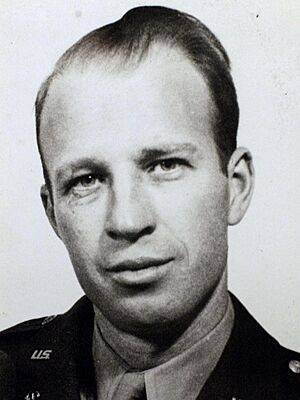Frank Olson facts for kids
Quick facts for kids
Frank Rudolph Olson
|
|
|---|---|
 |
|
| Born | July 17, 1910 Hurley, Wisconsin, United States
|
| Died | November 28, 1953 (aged 43) |
| Occupation | Bacteriologist, bioweaponeer |
| Years active | 1943–1953 |
| Spouse(s) | Alice Smith "Wicks" Olson |
| Children | 3 |
Frank Rudolph Emmanuel Olson (born July 17, 1910 – died November 28, 1953) was an American scientist. He studied bacteriology, which is the study of tiny living things called bacteria. He also worked on biological warfare, which means using germs or diseases as weapons. Olson worked for the United States Army Biological Warfare Laboratories at Fort Detrick in Maryland.
About Frank Olson
Early Life and School
Frank Olson was born in Hurley, Wisconsin. His parents were immigrants from Sweden. He finished high school in Hurley in 1927.
Olson then went to the University of Wisconsin. He earned two degrees there, including a Ph.D. in bacteriology in 1938. He married his classmate, Alice, and they had three children. To help pay for college, Olson joined the Reserve Officers' Training Corps. This meant he would serve in the military later.
Work with the Army and CIA
When World War II started, Olson was called to active duty in the U.S. Army. He became a captain in the U.S. Army Chemical Corps. In 1942, his former professor, Ira Baldwin, asked him to join a secret program. This program was about developing biological weapons. Olson became one of the first scientists at what is now Fort Detrick.
At Fort Detrick, Olson worked on the U.S. bioweapons program. This program started in 1943 during World War II. He also worked with scientists from other countries. They studied how to use anthrax as a fine mist.
Olson left the Army in 1944 but continued his research as a civilian. He studied how tiny particles travel through the air. In 1949, he went to Antigua for Operation Harness. This project tested how different animals reacted to toxic clouds. In 1950, he was part of Operation Sea-Spray. In this project, a type of bacteria called Serratia marcescens was released into the air over San Francisco. It reached many people in the city. Olson also often traveled to Fort Terry, a secret army base. Very dangerous toxins were tested there because it was far from the U.S. mainland.
During this time, military and CIA officials were worried about the Soviet Union's progress in microbe warfare. This led to the creation of the Special Operations Division (SOD) at Detrick in 1949. SOD focused on secret ways to use chemical weapons. It was very secret, even within Fort Detrick. Olson became the acting chief of SOD within a year.
At some point, Olson also began working for the Central Intelligence Agency (CIA). In May 1952, he was part of Project Artichoke. This was a secret CIA program that explored ways to get information from people.
Growing Concerns
By early 1953, Olson had officially joined the CIA. He stepped down as chief of SOD because of the stress of the job. However, he stayed with SOD, which was like a secret CIA research station inside a military base. His children later said that his work at Detrick had a lasting effect on him.
In February 1953, there were claims that the U.S. was using germ warfare during the Korean War. Some American pilots who were captured made these statements. After they were released, these prisoners said their statements were not true.
The Korean Armistice Agreement was signed in July 1953, ending the fighting in Korea. This led to Operation Big Switch, where prisoners of war were returned home. Olson, a bacteriologist, traveled to Europe around this time. His family noticed a change in his mood when he returned. A coworker said Olson had seen interrogations in Europe. He became convinced that the United States had used biological weapons during the Korean War. A journalist named Gordon Thomas claimed that Olson later visited a British psychiatrist. This psychiatrist reportedly said Olson had become a security risk.
Olson had worked at Detrick for ten years and knew many of its secrets. He often traveled to Germany to observe secret interrogation sessions.

